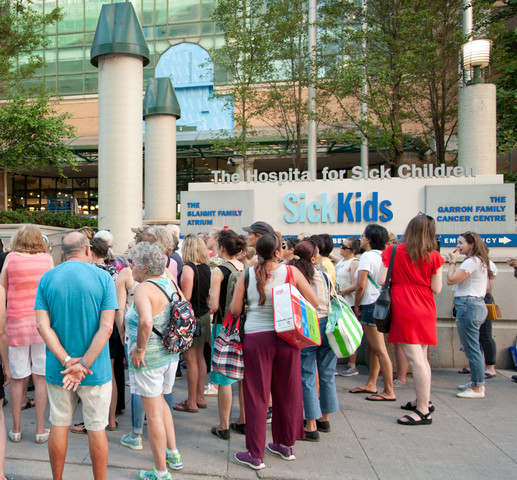
SickKids Hospital Women History
sickkids hospital women history
Tour group, SickKids Hospital, July 4, 2019. Image by Herman Custodio.
Convalescent ward, Hospital for Sick Children, 1902. Image: Toronto Public Library
Executive of Medical Undergraduate Women’s Council and Medical Y. W. C. A., with Dr. Gladys Boyd, University of Toronto, 1918. Image: University of Toronto Archives
Drs. Tisdall and Drake with Dr. Pearl Summerfeldt and lab technician Ruth Herbert, undertaking research on Pablum, 1930s. Image: Hospital Archives, The Hospital for Sick Children, Toronto.
SickKids Hospital
Elizabeth McMaster
The very existence of SickKids Hospital is due to a group of women volunteers. Recognizing the significant health risks to children in the 19th century, Elizabeth McMaster wanted to establish a children’s hospital in Toronto. She led a Ladies Committee to raise funds to open the Hospital for Sick Children. Opening its doors in 1875, the first hospital building was a two-storey house with six cots and no running water. Within a year, hospital services were in such high demand that it had to move to a larger building. Today, SickKids Hospital is a world-renowned institution. McMaster and her Ladies Committee made a monumental impact on the field of healthcare – during a time when women were barred from studying medicine in Canada.
Dr. Gladys Boyd
Dr. Gladys Boyd was one of four women to graduate from the University of Toronto Faculty of Medicine in 1918. She started a fellowship in pediatrics at the Hospital for Sick Children in 1920. The following year, she was appointed the head of Endocrine Services. Specializing in diabetes, as early as 1922, she used Banting and Best’s newly-discovered insulin to treat children. Working with Dr. Banting, the pair reduced childhood mortality from diabetes by 50% over a ten-year period. As a leading authority in the use of insulin, Dr. Boyd taught other physicians. Her work as a pioneer in insulin treatment saved incalculable lives.
Dr. Pearl Summerfeldt
In the 20th century, malnutrition was a serious problem, especially for children. In the 1930s, a team at the Hospital for Sick Children developed pablum – an ultra-nutritious cereal that could be quickly prepared by adding hot milk or water. Pablum provided over half of the daily calories needed by children – crucial in the midst of the Great Depression.
Dr. Pearl Summerfeldt started working at the Hospital for Sick Children in 1927 and was one of Canada’s first female pediatricians. She was an instrumental member of the team that invented pablum, although the credit is usually only given to a trio of male doctors. She had worked on the precursor to pablum, an irradiated wheat biscuit which laid the groundwork for the cereal. As well, her research on the effect of dietary vitamins on the growth of children proved the effectiveness of pablum and helped support the marketing of the product as ‘medically approved.’ Dr. Summerfeldt’s contribution to the development of pablum – a product still used today – was pivotal in the fight against childhood malnutrition.
Dr. Irene Uchida
Dr. Irene Uchida (born Ayako Uchida) was one of 22,000 Japanese Canadians interned during the Second World War. Later, she was able to continue her studies, earning a BA in English from the University of Toronto. Interested in genetics, she continued on to receive a PhD in zoology in 1951. She began her career as a research associate at the Hospital for Sick Children. Dr. Uchida developed a database of information on twins to help study genetic disorders. After leaving the hospital in 1959, she continued her work in genetics and childhood medicine in Canada and the US.
Dr. Uchida’s career breakthroughs include the discovery that X-rays performed on pregnant women led to a higher chance of Down syndrome. She also determined that either parent, not just the mother, could be responsible for the extra set of chromosomes that cause the condition. In 1993, she became an Officer of the Order of Canada, recognized for her contributions to the field of medicine.
LISTEN to an episode of “The Secret Life of Canada” podcast for more information on Dr. Uchida’s life.
*Sources:
David Wright, Sick Kids: The History of the Hospital for Sick Children. Toronto: University of Toronto Press, 2016.
Heather Gardiner, “Dr. Gladys Boyd: a pioneer in childhood diabetes care,” Women’s College Hospital, November 14, 2011.
Dickson, Kathleen, and John Bergeron, “Irene Uchida“. In The Canadian Encyclopedia. Historica Canada. Article published March 26, 2020; Last Edited March 26, 2020.

